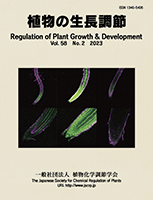Volume 58, Issue 2
Displaying 1-16 of 16 articles from this issue
- |<
- <
- 1
- >
- >|
The Society Awards Lectures-The JSCRP Award
-
Article type: The JSCRP Award
2023 Volume 58 Issue 2 Pages 69-77
Published: 2023
Released on J-STAGE: May 10, 2025
Download PDF (3146K)
Feature Articles:New development in strigolactone studies
-
Article type: Feature Articles:New development in strigolactone studies
2023 Volume 58 Issue 2 Pages 78-79
Published: 2023
Released on J-STAGE: May 10, 2025
Download PDF (308K) -
Article type: Feature Articles:New development in strigolactone studies
2023 Volume 58 Issue 2 Pages 80-86
Published: 2023
Released on J-STAGE: May 10, 2025
Download PDF (1802K) -
Article type: Feature Articles:New development in strigolactone studies
2023 Volume 58 Issue 2 Pages 87-94
Published: 2023
Released on J-STAGE: May 10, 2025
Download PDF (1990K) -
Article type: Feature Articles:New development in strigolactone studies
2023 Volume 58 Issue 2 Pages 95-99
Published: 2023
Released on J-STAGE: May 10, 2025
Download PDF (1409K) -
Article type: Feature Articles:New development in strigolactone studies
2023 Volume 58 Issue 2 Pages 100-104
Published: 2023
Released on J-STAGE: May 10, 2025
Download PDF (1680K)
Reviews
-
Article type: Reviews
2023 Volume 58 Issue 2 Pages 105-111
Published: 2023
Released on J-STAGE: May 10, 2025
Download PDF (1012K)
Research Notes
-
Article type: Research Notes
2023 Volume 58 Issue 2 Pages 112-119
Published: 2023
Released on J-STAGE: May 10, 2025
Download PDF (2447K) -
Article type: Research Notes
2023 Volume 58 Issue 2 Pages 120-127
Published: 2023
Released on J-STAGE: May 10, 2025
Download PDF (5462K) -
Article type: Research Notes
2023 Volume 58 Issue 2 Pages 128-134
Published: 2023
Released on J-STAGE: May 10, 2025
Download PDF (5234K) -
Article type: Research Notes
2023 Volume 58 Issue 2 Pages 135-141
Published: 2023
Released on J-STAGE: May 10, 2025
Download PDF (2408K) -
Article type: Research Notes
2023 Volume 58 Issue 2 Pages 142-147
Published: 2023
Released on J-STAGE: May 10, 2025
Download PDF (1525K) -
Article type: Research Notes
2023 Volume 58 Issue 2 Pages 148-154
Published: 2023
Released on J-STAGE: May 10, 2025
Download PDF (2292K)
Science Saloon
-
Article type: Science Saloon
2023 Volume 58 Issue 2 Pages 155-159
Published: 2023
Released on J-STAGE: May 10, 2025
Download PDF (3821K) -
Article type: Science Saloon
2023 Volume 58 Issue 2 Pages 160-161
Published: 2023
Released on J-STAGE: May 10, 2025
Download PDF (1726K) -
Article type: Science Saloon
2023 Volume 58 Issue 2 Pages 162-167
Published: 2023
Released on J-STAGE: May 10, 2025
Download PDF (532K)
- |<
- <
- 1
- >
- >|
